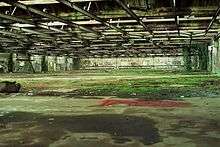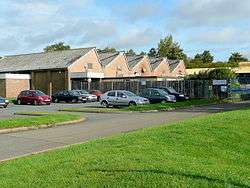ROF Rotherwas
ROF Rotherwas was a Royal Ordnance Factory filling factory, No 4, located in Lower Bullingham, Herefordshire, England.
Background

By the turn of the 20th century, the Lubienski-Bodenham family - descended from Mary Tudor, the daughter of King Henry VII - owned the Rotherwas estate, which combined of 2,500 acres (1,000 ha) on the south side of the River Wye. After the death of his wife in 1908, following the death of Count Louis Pomian Lubienski-Bodenham JP DL in 1909 (his great-grand daughter is actress Rula Lenska), having already demolished their country house, sold-off the estate in 1912. At the resultant auction, Herefordshire County Council bought 185 acres (75 ha) that was overlooked by Dinedor Hill and was bordered by the Wye meadows.[1][2][3]
World War I
At the outbreak of World War I, the Ministry of Munitions were looking to create a number of munitions production facilities quickly and cheaply. A site of 100 hectares (250 acres) was acquired by the Ministry on 15 June 1916, located south of Hereford on the junction of the Welsh Marches Line and the Hereford, Ross and Gloucester Railway. Laid out to a standard design, the site encompassed:[1][2]
- 27 miles (43 km) standard gauge railway
- 3 miles (4.8 km) of roads
- 9 miles (14 km) of guard fence
- 10 miles (16 km) of footpaths and sentry paths
- 370 buildings varying in floor area. Like a typical munitions facility, the buildings were widely spaced on safety reasons, to avoid complete destruction of the facility in case of an explosion
- A rail connected outpost was established at Credenhill, were a munitions store was stablished. During WW2 this land was again requisitioned for defence, and became RAF Hereford, now the home of the Special Air Service.
All components were produced elsewhere, with the facility responsible for final production: inserting explosive into shells, and fitting detonators. Shell filling began on 11 November 1916, with both Lyddite and Amatol explosives being used in production. From June 1918, alongside the main plant at Banbury and supporting site at Chittenden; all three were supplied with dichloroethyl sulphide by the National Smelting Company at Avonmouth Docks, to produce mustard gas shells.[4][5] By the ed of WW1, the average output of shells from the facility was 70,000 per week.[1][2]
At peak of 6,000 employees; by October 1918, there were 5,943 employees, 3,977 of which were women.[3] Workers were transported in from billets in Hereford, Leominster and Ross on Wye. Dedicated trains were run from Hereford Barrs Court railway station to the specially built factory station, with free tickets supplied to all employees.[1][2]
Between the wars
The only ROF of 25 sites retained between the wars, it was put into care and maintenance from 1920.[3] From 1926 onwards it resumed filling gas shells, staffed by about 400 men. By the late 1930s it was used by the Royal Navy for filling sea mines.[1][2]
World War II
During World War II, the facility was used to produce shells, and bombs for the Royal Air Force. The site employed over 8,000 staff, mainly women.[2] The site suffered three major incidents:[1]
- 12 September 1941: a milling machine overheated, creating explosions with killed three people
- 27 July 1942: a single Nazi Luftwaffe bomber dropped 2 x 250 kg bombs, killing 22 people
- 30 May 1944: a 2,000 pounds (910 kg) bomb during filling operations exploded, setting off a chain reaction. The filling house, located in the south east of the complex, was destroyed, whilst the surrounding buildings were damaged to various extents. The Ministry redeveloped the affected area, and medals were awarded for bravery: five George Medal, one Order of the British Empire, one Member of the Order of the British Empire; nine British Empire Medals, and 34 other commendations.[1]

Present
With vastly reduced production after World War II, the town and county council lobbied for various business to relocate to the site. As the ROF was reduced in scale, parts of the site were redeveloped with various commercial industrial facilities.[1][2]
The ROF closed in 1967. In 1975 Herefordshire County Council bought 93 hectares (230 acres) for redevelopment an industrial estate. A number of World War I buildings survive, as does a group of World War II Romney huts to the north-east, now used as industrial starter units.[1][2]
References
- "Royal Ordnance Factory Rotherwas". Herefordshire County Council. Archived from the original on 14 May 2014. Retrieved 13 May 2014.
- Edmonds, John (2004). The History of Rotherwas Munitions Factory, Hereford. Logaston Press.
- "Rotherwas Ordnance, Hereford". archaeologists.tv. Retrieved 13 May 2014.
- Haber L.F. (1986). "10". The Poisonous Cloud. Oxford University Press. ISBN 9780198581420.
- Ian F.W. Beckett. The Home Front 1914-1918: How Britain Survived the Great War. Retrieved 13 May 2014.